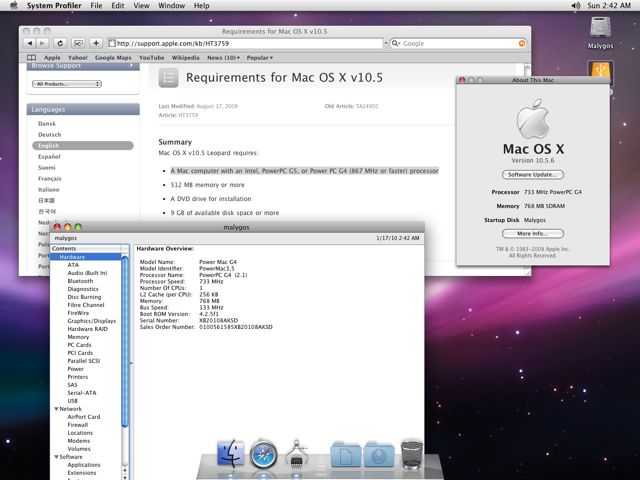As some of you might know, I own an old Power Mac G4, one of the QuickSilver 2001 models. 733MHz processor, 768MB of RAM (soon to be 1.25GB!), 40GB HDD, CD-RW drive, pretty nice system...for 2001.
I was playing around with it today and, well...

(click to enlarge - 1280x960)
When Apple says that a 867MHz processor is required they're not messing around. The installer will actively prevent installation on a 733MHz system. I don't have another Mac, so I can't even install it on one system and restore a DMG onto my tower. Additionally, I don't have a DVD-ROM drive in this system, so how could I possibly install the OS? No CD distribution was ever released for Leopard -- that stopped with Tiger.
It's funny, but in some ways this is like having another Hackintosh in the house -- both are using operating systems that they aren't intended to run (though you could argue that the Apple-branded Mac running Leopard is a bit less extreme). The installation files have been untouched, so there are no installer package hacks to get around the. As far as the real Mac is concerned it can't even boot to the media. So, how was Leopard installed and run on it?
The main reason that all of this worked without any real novel trickery is due to one thing: Open Firmware. The reason that it allows you to do such things is coming up.
First of all, we need to solve the mystery of how you could boot to the media. The first step was to create an image of the Leopard install disc with a system fitted with a DVD drive -- my "Wintel" tower, in this case. In an ideal world, I could have simply dumped the image onto an external hard drive. In fact, if I had a FireWire hard drive I could have done this and simply booted to that drive. However, the model that I'm dealing with doesn't support USB booting at all. Remember, this is in 2002, where the fact that this system mandated the use of a USB keyboard and mouse was outrageous. Hell, the fact that USB 1.1 was the dominant standard would have ensured that anyone would have gone batshit crazy trying to install an OS from a USB drive (note: one upgrade that I did slap into this system a few months ago was a USB 2.0 PCI card, so I didn't have to wait hours for the image to transfer).
Long story short, we're going to have to be a little clever if we want to boot to that image.
To solve the dilemma, I turned to Tiger. I booted to my Tiger CD and went to Disk Utility. I partitioned the internal hard drive, dumping the image onto a 10GB partition and leaving the other 30GB open for the install. If you only have experience with PC-compatible hardware, you're probably going to be wondering what kind of trickery I used to boot to that partition and get the process going.
The simple answer is that there is absolutely no trickery required. PC-compatibles require boot code to be present in the first sector of the drive that's being booted to (it can be a total of 510 bytes -- not including the required two byte magic at the end of the sector -- and can jump to other sectors for more advanced work). Some boot loaders -- such as the one for DOS and Windows 9X -- are simple, containing only the required code to boot into a single operating system. Others, such as GRUB, LILO, and the NT boot loader, are significantly more advanced. Some newer systems allow you to boot to other hard drives at will, giving you the possibility of having multiple boot loaders without requiring chain loads, but it's all basically the same thing.
Open Firmware (and EFI, when it's used effectively), on the other hand, allows you to boot to literally any device that the system firmware supports, letting you go so far as to load a specific kernel. This allows me to boot directly to the image on the hard drive without having to do anything fancy. In fact, when you run the Startup Disk application from within the Tiger installer, the Leopard drive appears in the list. Booting to that will let me run the installer, but...wait a sec.
That doesn't change the fact that I still have a 733MHz processor. Leopard will quickly detect this and forbid me from doing the installation. It seems like it would be trivial to patch the package file so that it bypasses the CPU check, but our goal is to do this without patching files on the CD. This hurdle, like the last one, is also resolved by Open Firmware, only this time we have to actually jump into the Open Firmware shell.
In addition to actually pointing the system to the correct boot files, Open Firmware also provides system information to the operating system. Humorously enough, this information can also be manipulated by the user, provided he/she knows where to go.
As it turns out, the following two lines can be used to set what clock rate OS X detects:
dev /cpus/PowerPC,G4@0
d# 867000000 encode-int " clock-frequency" propertyFinish it all off with a
mac-boot and the Leopard installer will boot up from the hard drive and happily install the operating system on an under-spec Mac. The modified clock-frequency property doesn't persist through a reboot, so when you boot into the Leopard installation it'll be back to what it should be but the OS won't care at that point (as demonstrated in the screenshot).
So, there you have it. This is the kind of crap that I do late in the evening on weekends. Woot.